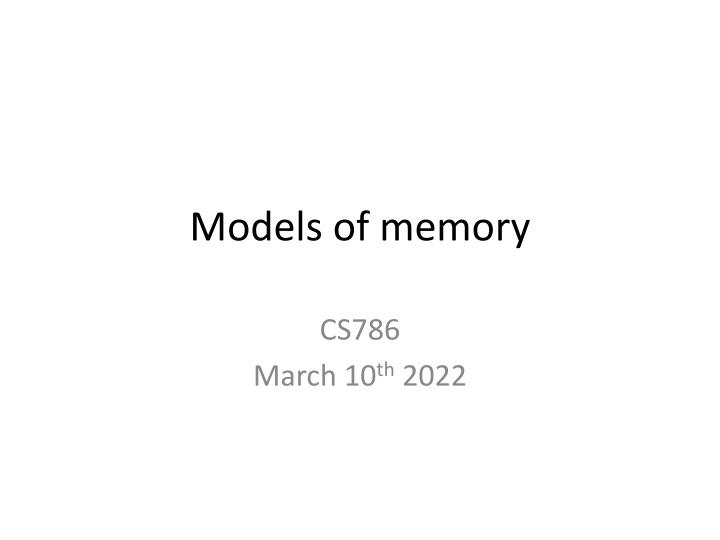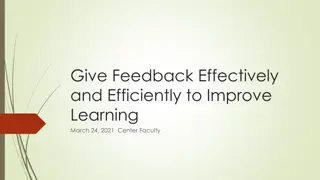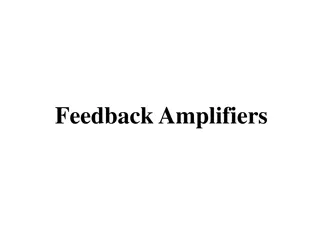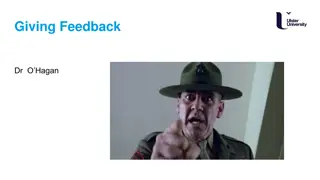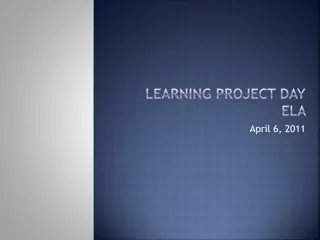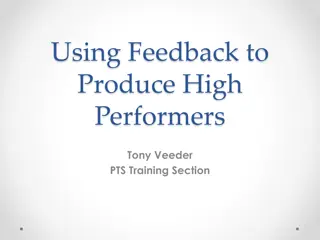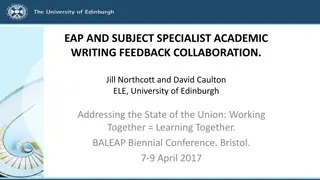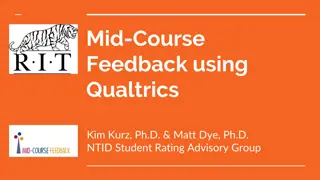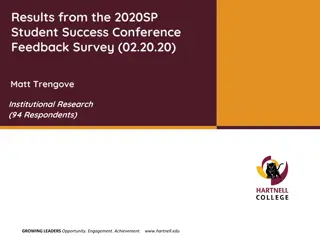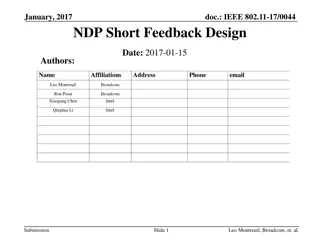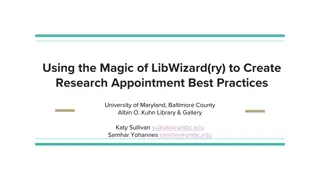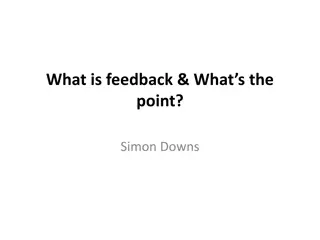SWPB4L Conference 2014 Feedback and Strategies
Utilize evidence-based systems to promote a positive school climate and enhance social skills through a multi-tiered approach, emphasizing teaching, modeling, and reinforcing pro-social behaviors for academic and behavioral success.
Download Presentation

Please find below an Image/Link to download the presentation.
The content on the website is provided AS IS for your information and personal use only. It may not be sold, licensed, or shared on other websites without obtaining consent from the author.If you encounter any issues during the download, it is possible that the publisher has removed the file from their server.
You are allowed to download the files provided on this website for personal or commercial use, subject to the condition that they are used lawfully. All files are the property of their respective owners.
The content on the website is provided AS IS for your information and personal use only. It may not be sold, licensed, or shared on other websites without obtaining consent from the author.
E N D
Presentation Transcript
Models of memory CS786 March 10th2022
Random access memory Computer memory can be randomly accessed given address locations Address in RAM Data out But human memory doesn t have consistent physical addressing. So how does it still work effectively?
Content addressable memory Content addressable memories are used in some high-speed search operations Data in CAM Address out Human memory is closer to content addressable than random addressable https://en.wikipedia.org/wiki/Content-addressable_memory
Retrieval depends on joint encoding Neurons that fire together wire together Hebbian postulate Any memory encoding must store both the target to be stored and the cue that will trigger its retrieval Can t store single items in memory But what are retrieval cues? Hard to identify in natural settings Hard to nail down even in experimental settings In principle, could be any datum of experience
Encoding experiences in memory Not as straightforward as putting things in boxes and taking them out later How is the experience represented? How is it indexed? How is it retrieved? What factors affect encoding?
Environmental Effects on Encoding Encoding specificity principle proposes that the cues present during encoding serve as the best cues for retrieval This is why elaborative rehearsal helps memory performance Elaborative rehearsal plant: tree :: sea: o____, generating targets helps in retention State-dependent memory is memory that depends upon the relationship of one s physiological state at the time of encoding and at the time of retrieval Relationship of smell to memory is a common literary trope, see c.f. Proust s Remembrance of things past
Environmental Effects on Encoding Mood-dependent memory effects attest to the fact that memory is better when a person s mood is the same during encoding and retrieval For example, if you are happy during encoding information, it is easier to retrieve that information if you are happy at the time of retrieval Mood-congruence effect is the fact that memory is better for experiences that are congruent with a person s current mood For example, when we are sad it is easier to retrieve negative events in our lives
Encoding Specificity When conditions of retrieval are similar to conditions of encoding, retrieval is more likely to be successful You are more likely to remember things if the conditions under which you recall them are similar to the conditions under which you learned them
Encoding Specificity Context effects environmental cues to recall State dependent retrieval physical, internal factors Mood Congruence factors related to mood or emotions
Encoding-dependent memory tricks Thespacing effect (or distributed study effect) shows that your memory will improve if you study for an exam over an extended time interval rather than just a few days before the exam Can be because studying in a diverse set of circumstances makes more retrieval cues accessible for encoding Overlearning is studying material past the point of initial learning, and has been demonstrated to aid in retrieval of that information Can be because multiple retrieval cues are associated with the same target, aiding retrieval
Measuring memory performance Recallis a measure of retrieval that requires the reproduction of the information with essentially no retrieval cues Typical measure = # of items successfully retrieved/# of items on list Recognitionis a measure of retrieval that only requires the identification of the information in the presence of retrieval cues Typical measure = d in n-AFC with n-1 non-targets Relearning, also called the savings method, is a measure of the amount of time saved when learning the information for a second time
Why do we forget? Sensory memory The senses momentarily register amazing detail Forgetting can occur at any memory stage Short-term memory A few items are both noticed and encoded Long-term storage Some items are altered or lost Retrieval from long-term memory Depending on interference, retrieval cues, moods, and motives, some things get retrieved, some don t
Why We Forget Encoding failure : sometimes forgetting is not really forgetting, information never entered long-term memory in the first place Storage decay theory suggests that forgetting occurs because of a problem in the storage of the information The biological trace of the memory gradually decays over time and the periodic usage of the information helps to maintain it in storage Highly recommended extra work: watch Inside Out
A classic relearning experiment Ebbinghaus conducted the first experimental studies on human memory more than 100 years ago using the relearning method. He would study a list of nonsense syllables until he could correctly recite the complete list without any hesitations. He then put the list aside and waited some period of time and then relearned the list to the same criterion. To get a measure of learning, he computed a savings score the reduction in the number of trials it took him to reach criterion. Result? The forgetting curve reveals that most forgetting occurs in the first two days after learning material.
Forgetting Curve for Long-Term Memory
Decay Theories 100 100% 90 Memories fade away or decay gradually if unused Time plays critical role Ability to retrieve info declines with time after original encoding Lately subsumed quite well by cue-dependent forgetting theories Average percentage 80 70 of 60 information retained 50 40 30 20 10 0 20 mins 1 hr 8 24 hrs 2 6 31 days hrs days days Interval between original learning of nonsense syllables and memory test
Why We Forget Cue-dependent theory says we forget because the cues necessary for retrieval are not available The information is in memory, but we cannot access it This theory is analogous to knowing a book is in the library but you cannot access it because the library lacks call numbers Interference theory proposes that other similar information interferes and makes the forgotten information inaccessible
Types of Interference Proactive interference occurs when information you already know makes it hard to retrieve newly learned information Retroactive interference occurs when information you just learned makes it hard to retrieve old information
Types of Interference Think about changing phone numbers after having a certain number for many years. When asked for your new phone number, remembering the old one interferes with retrieving the new one. This is proactive interference Now think about being at a party with many people you don t know. You meet someone whom you want to talk to later, but after meeting her, you are introduced to many more people. Now, you cannot remember her name. This is retroactive interference
Modeling these facts together SEARCH OF ASSOCIATIVE MEMORY
Elements of memory models Search To explain list-length and fan effects Direct access To explain rapid true negatives in recognition Implicit recognition To explain the mind s solution to the correspondence problem https://pdfs.semanticscholar.org/7ebc/6fb776eb2250da7c925946424b9fee37097c.pdf
Modeling retrieval Search of associative memory (SAM) was the first modern computational model of memory retrieval (Gillund & Shiffrin, 1984) Assumes that information is stored in a distributed manner as memory images Images contain item, associative and contextual information Retrieval is modeled as a cue-dependent process Whether an image is retrieved or not is a function of the associative strengths of the retrieval cues to that image Single process model of recall and recognition
SAM implementation Assume the retrieval probe contains multiple cues Q1, Q2, Qm Combined activation of image Ii is a multiplicative combination of individual image-cue associations Probability of sampling an image is a simple Luce choice rule Not the same as the probability of successful memory retrieval An image may or may not activate recovery of the correct target of retrieval
SAM implementation Probability of successful recovery Probability of recall success If attempt succeeds, association between probe cues and sampled image strengthens SAM had basic learning built into it
Successful predictions List length effects in recall Probability of sampling an item decreases as the number of items increases Presentation time effects Increased presentation time stronger associations better recall and recognition Primacy effects In recall because of reinforcement of previous samples In recognition because of the generation of new images corresponding to each successful recognition
Successful predictions Part set cuing Cuing set reduces set of items that can be sampled from This is what the browser experiment is testing Word frequency effects Recall prefers high frequency items because they have more associations Recognition prefers low frequency items because there is a lower variance in the associative strength distribution for LF items
SAM failures Long term recency effects Null list length effect in recognition Empirical list length observations in recognition confounded with time to testing Recognition memory for up to 10000 images documented (Standing, 1973; Brady et al., 2014) List strength effect Strength of items = presentation time Recognition of strong items in lists of purely strong items better than in mixed lists Recognition of weak items in lists of purely weak items worse than recognition in mixed lists Mirror effect Greater true positives and fewer false positives in recognition of low frequency items
Temporal context model SAM makes no assumptions about the effect of the environment on retrieval cues guiding the memory process Accepted as inputs Recent retrievals can become cues for subsequent retrievals The temporal context model (TCM) changes this Assumes a linear drift of the temporal context cue that goes into every episodic memory encoding Recommended reading: (Howard & Kahana, 2002)
TCM encoding Items are represented as feature vectors f Context is also represented as feature vectors c on a different feature space Both item and feature vectors are time- indexed Construct an item-context mapping via an outer product
TCM retrieval Retrieval happens via spreading activation A state c on C will provide activation input fout = MFC c Similarity of this input to a given item f can be measured as a dot product This quantifies the retrieval pull the context exerts on each item Follows from f orthonormality (assumed)
The context drift assumption Assume a linear drift in context A little bit like a recurrent network Naturally makes contexts at closer times more similar than contexts at farther times from the probe point Yields long-term recency predictions
